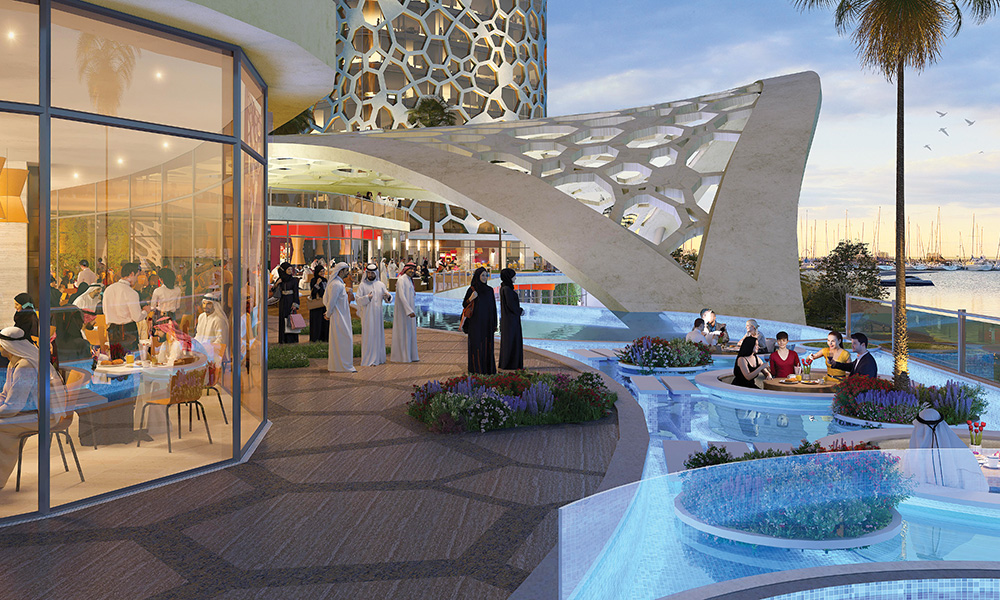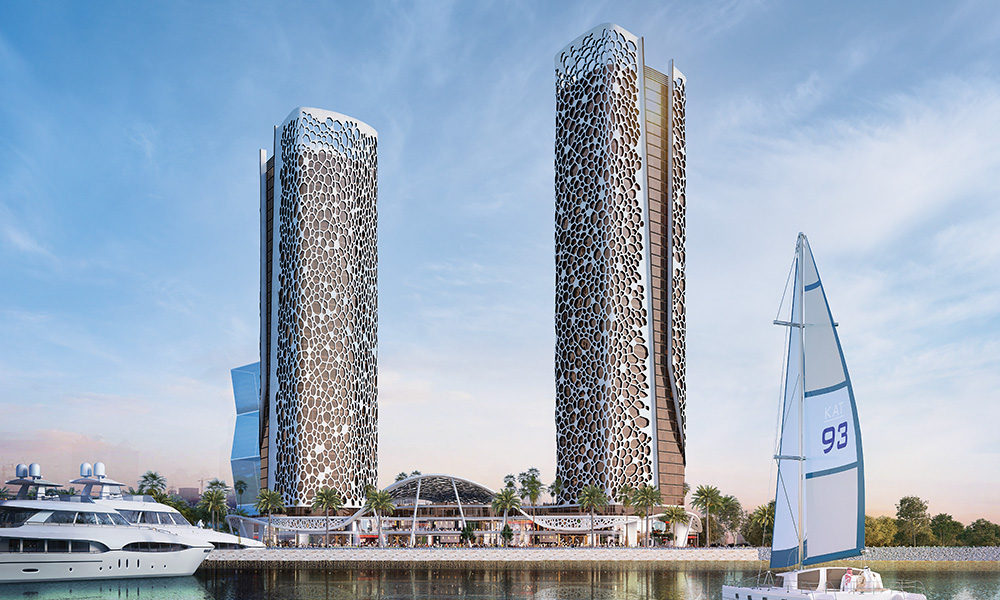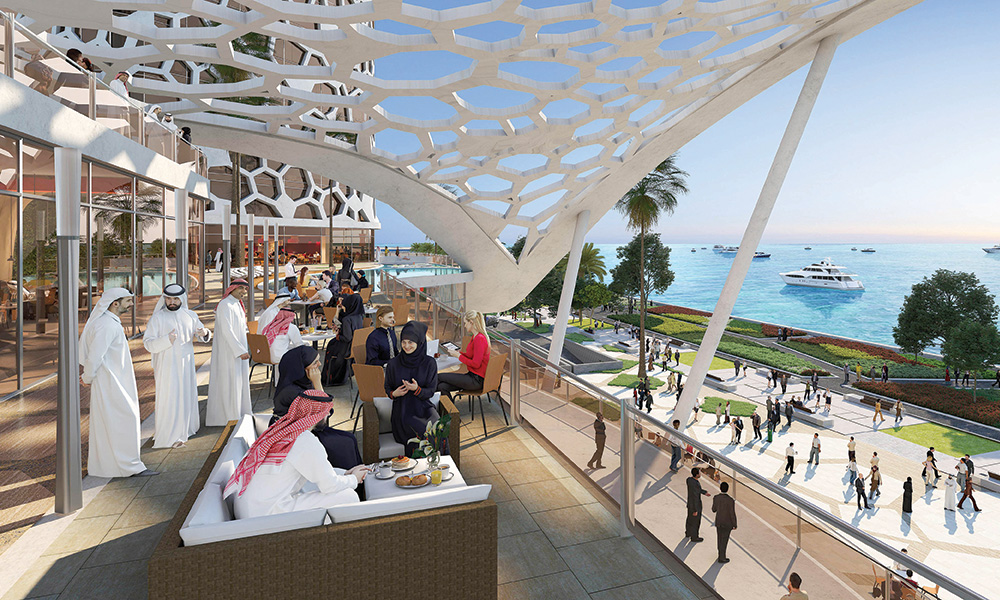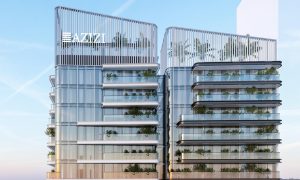A new hospitality benchmark rises in Qatar
Arab Engineering Bureau explains how they utilised Bentley System’s RAM Concept to deliver the Rosewood Doha – a project set to redefine Qatar’s hospitality landscape

Located within the $45bn Lusail City development spanning 38sqkm across four islands, the Rosewood Doha is the Middle East’s new ultra-luxury destination.
The development comprises two towers linked at the base by a three-level podium, reaching a built-up area of 152,684sqm. The 40-story residential tower will house 300 apartments, promising to deliver the pinnacle of luxury living in Qatar, with a range of bespoke amenities and services.
The 37-story hotel tower will feature 154 hotel rooms and 161 apartment suites, along with a rooftop terrace, restaurants, and eateries poised to provide a dynamic culinary experience. Both towers stand on a rectangular base, turned perpendicular to one another, allowing maximum exposure to the water and marina views.
The Rosewood’s design was inspired by local underwater coral formations, showcasing an organic architectural approach aimed at respecting the site and its surrounding Arabian Gulf waters, while promoting harmony between human habitation and nature.
“Rosewood Doha and Rosewood Residences Doha will create a new and differentiated benchmark for ultra-luxury hospitality in the region,” says Sonia Cheng, Rosewood CEO. Arab Engineering Bureau (AEB) conceptualised the design and is responsible for structural engineering through to construction to realize their innovative development concept.
With curvilinear cladding for the podium that complements the organic façade of the towers and gives the impression of two corals, the striking architecture will make the building a city landmark. In order to achieve the client’s brief, AEB needed skill and creativity to bring the design to life.

Supporting an Organic Architectural Design Concept
To support the Rosewood’s organic architectural design concept, AEB faced structural engineering challenges that included designing a cantilever slab support system on four corners amid a tight project budget.
“One of the client’s requirements was to keep the project on a tight budget and the structural system is a cantilever slab on four corners. Designing such a slab system would be difficult and challenging,” explains Ibrahim Jaidah, Chief Architect and Group CEO, AEB.
The design team wanted to use a post-tension steel slab as opposed to a conventional flat concrete slab system to meet the cost constraints while creating column-free spaces to create open floor plans.
Designing such a structural system required them to consider the complete geometry of the towers and podium, including column and beam sizes and locations, slab thickness, and concrete dimensions, as well as analyse design loads, stress, deflection, and tendon layout. To ensure accurate calculations for optimal structural integrity while meeting the architectural requirements, AEB required comprehensive, customisable structural design technology.
Designing the optimal structural system
In order to achieve their requirements, AEB selected RAM Concept, as its large variety of design codes and design capabilities could easily cover all aspects of the flooring system.
“Using RAM Concept for structural design includes the availability of a large variety of design codes and it is a highly customisable software that contains design tools to cover all aspects of the flooring system,” says Jaidah.

Using Bentley’s structural engineering application, AEB modelled and analysed both towers and considered all loads from an architectural and multi-discipline design perspective. This analysis determined the optimal outputs and tendon layout for all post-tension floor slabs. They also used the software to determine the slab thickness with the reinforcements, applying varying loads and producing conceptual structural drawings based on the architectural layout.
The interoperability and automated features of RAM Concept enabled AEB to work with different disciplines and easily modify the model to incorporate changes and digitally represent the actual condition of the slab.
Through accurate modelling and analysis, they eliminated all beams, reducing the height between floors, creating more space above and below the ceiling for mechanical and electrical equipment, and adding additional rooms and apartments within the same overall tower height.
“In this project, we eliminated all beams. RAM Concept’s features give us the accurate punching shear stress and accurate deflection that allowed us to accurately simulate the slab and modify the tendon layout,” Mohamed Mosallam, Lead Structural Engineer at AEB, points out.
Driving savings and sustainability through advanced technology
Compared to other structural engineering software, RAM Concept provided an interoperable, user-friendly interface capable of delivering an optimal structural design solution, Mosallam says.
“The main key features and advantages of the punching shear stresses, tendon layout, and [capability to] export the tendon layout are features not available in other software,” he adds.

By accurately modelling and analysing the post-tension steel slab system using the application, AEB was able to determine that increasing the tendon layout in specific locations reduced the concrete slab thickness and enabled them to eliminate the beams. This steel structural support solution reduced the concrete volume by 25%, saving 20% to 30% in costs.
The use of the technology simplified and automated previously manual tasks, saving AEB 20% to 30% in resource hours and helping them complete the structural engineering work ahead of schedule, the firm says. Using the post-tension technique and RAM Concept led to a significant reduction in the design and construction processes for both towers.
“Comparing this process with any other structural software, we highly recommend RAM Concept to complete the design with the highest level of accuracy,” says Mosallam.
The post-tension steel structural design not only improves structural durability and reduces maintenance costs, but it also plays a vital role in achieving the sustainability requirements of the building, which is targeted at a 4-star Global Sustainability Assessment System (GSAS) rating, he highlights in conclusion.
Read more:
- ALEC steps up digital construction focus, earns BIM Kitemark certification
- Gallery: First reveal of the new design of the Notre-Dame de Paris surroundings
- Using digital twin technology in the metaverse to resolve complex infrastructure issues
























